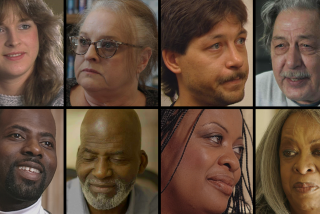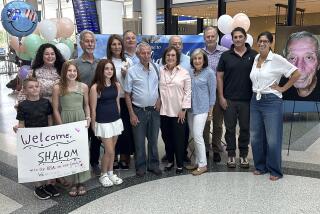Both Sides Now : An Author’s Account of Her Family’s Descendants--Black and White--Strikes a Chord With People She Meets on a Book Tour. It’s Like Having ‘Roots in Several Gardens,’ One Man Tells Her.
- Share via
“The Sweeter the Juice” is Shirlee Taylor Haizlip’s account of the two sides of her family, one that has lived as black people and the other that has lived as white. The fair-skinned descendant of an Irish immigrant and a slave wrote about the arbitrariness of racial designations. Her themes of family, race, color and class struck a nerve with scores of people she met recently on a 10-city book tour across the United States. These are some of the stories they shared with her.
Clutching a copy of my book to his chest as if it were some ancient poultice soothing an equally ancient wound, a middle-aged, caramel-colored black Angeleno looked as if he were about to cry.
“I know this story,” he said. “It happened in my family in St. Louis. My mother’s brother left the race and passed for white, but he did not leave St. Louis. One day, when I was about 8, I was walking with my mother and she saw her brother coming toward her on the street. When he saw her, he turned and ran. She never saw him again. Ever since that day, I have had a deep and abiding rage for my uncle.”
And in a Melrose Avenue restaurant, a blue-eyed woman whose sleek red hair framed a pale face asserted that she and I had something in common: “We are both the great-granddaughters of slaves.”
That was one of the few times I was astonished by someone who claimed to be of the same ethnic origin as I. The other was at a book party at a Yale professor’s house in New Haven. After my talk, a pleasant young man whose pale blond eyebrows were almost indistinguishable from the skin of his forehead confided that from that night on, he was going to live his life differently. “I’ve been recognizing only one-half of myself, you know.”
“Which half was that?” I asked.
“Well, my mother is a white woman and my father is black, and all of these years I have identified only as a black person.” A lesson to me that it is never wise to make an assumption.
At Wellesley College, the black students giggled and snorted knowingly as I recalled the lack of black hairdressers in town when I was a student--something that apparently had not changed in 30 years.
While waiting to go on air with a National Public Radio interview in Washington, D.C., I was approached by a pretty, dark-haired girl who at first glance might have been Irish or English. “I like the message in your book,” she offered cheerfully. “I’m mixed race, you know, but most people don’t know it unless I’m with my family; then they look confused or puzzled. One of my parents is Japanese and the other is white, and I took my looks after the white side. All of my siblings look Japanese. But I feel fortunate because I grew up in California and was brought up with great care to honor both sides of my family.”
In Seattle they stood in line with their pictures. One woman told of an aunt and first cousins who lived as white, while she and her still sorrowful mother lived as black. From their pictures I could see no difference. An older white man showed me the picture of his obviously black grandchild. “I thought he could only be considered black, and this made me feel bad. What about our side of the family? I often asked. But maybe a new day is coming and he, like you, can say he has roots in several gardens.”
At a bookstore in Stanford, a well-groomed middle-aged white man shook my hand and said that my book had inspired him to heal the schism in his family. By now I had learned to expect the unexpected. “Which side of your family was black?” I asked.
“Neither,” he responded, looking bemused. “It was a class schism. The part of the family I belong to is upper middle class. The other branch is working class. I tried once to reach out, but it just didn’t work. I guess I really did not try hard enough. But I feel the need to try again. Thanks for making me want to do it.”
In Berkeley, the white hostess of a radio program told me that her mother had found my book comforting, but not because of color issues. Her mother had been an adopted child, and at the age of 52 located her biological mother. The adopted child called the mother and asked her why she had put her up for adoption. The mother simply said, “I was just 13 when I had you. But there hasn’t been a day when I haven’t thought of you. I married your father and we had seven other children. They don’t know about you, but I want you to come over and meet them.”
The adopted daughter had a successful reunion with her biological parents and her siblings. She has been embraced by the family and now sees them often.
There is a great deal of pain in the American family. Seeking out and recognizing our very real genetic connections, rather than our constructed social differences, will begin to ease the pain.
More to Read
Sign up for our Book Club newsletter
Get the latest news, events and more from the Los Angeles Times Book Club, and help us get L.A. reading and talking.
You may occasionally receive promotional content from the Los Angeles Times.








